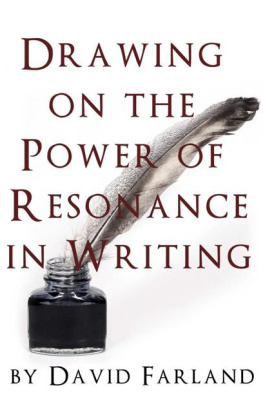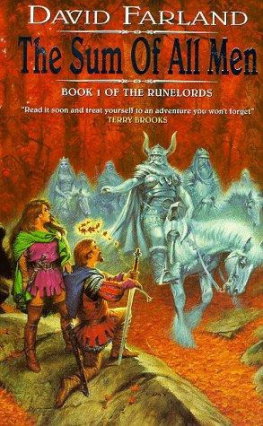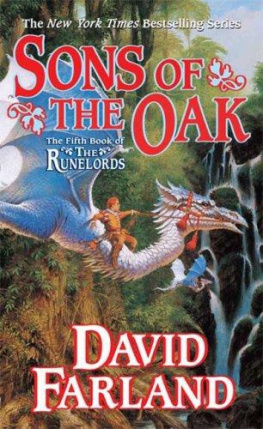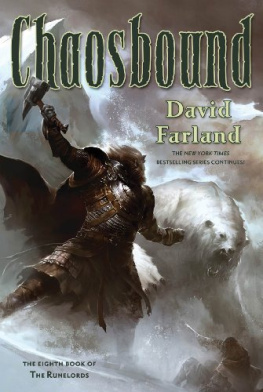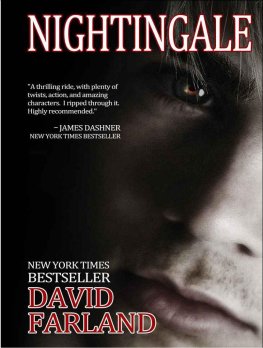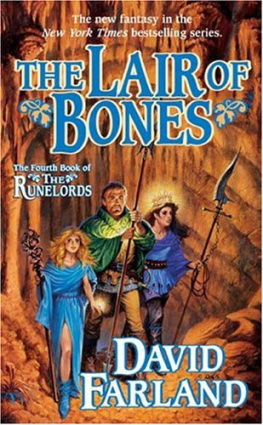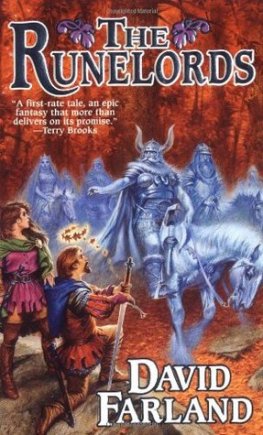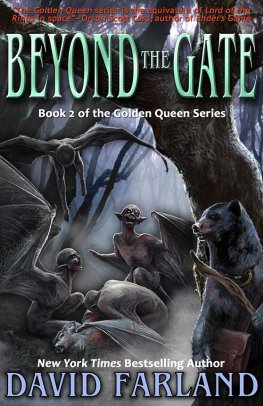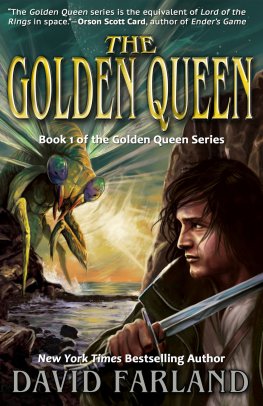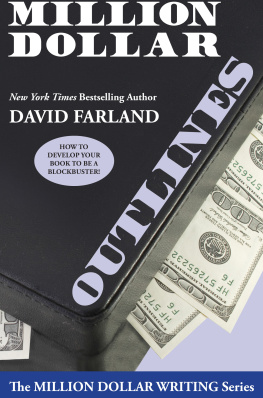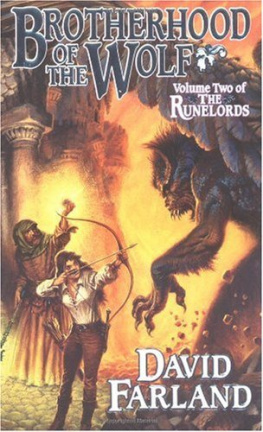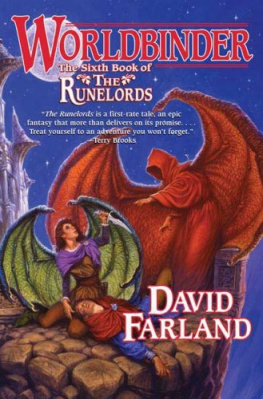David Farland - Drawing on the Power of Resonance in Writing
Here you can read online David Farland - Drawing on the Power of Resonance in Writing full text of the book (entire story) in english for free. Download pdf and epub, get meaning, cover and reviews about this ebook. year: 2012, genre: Home and family. Description of the work, (preface) as well as reviews are available. Best literature library LitArk.com created for fans of good reading and offers a wide selection of genres:
Romance novel
Science fiction
Adventure
Detective
Science
History
Home and family
Prose
Art
Politics
Computer
Non-fiction
Religion
Business
Children
Humor
Choose a favorite category and find really read worthwhile books. Enjoy immersion in the world of imagination, feel the emotions of the characters or learn something new for yourself, make an fascinating discovery.
- Book:Drawing on the Power of Resonance in Writing
- Author:
- Genre:
- Year:2012
- Rating:3 / 5
- Favourites:Add to favourites
- Your mark:
- 60
- 1
- 2
- 3
- 4
- 5
Drawing on the Power of Resonance in Writing: summary, description and annotation
We offer to read an annotation, description, summary or preface (depends on what the author of the book "Drawing on the Power of Resonance in Writing" wrote himself). If you haven't found the necessary information about the book — write in the comments, we will try to find it.
Drawing on the Power of Resonance in Writing — read online for free the complete book (whole text) full work
Below is the text of the book, divided by pages. System saving the place of the last page read, allows you to conveniently read the book "Drawing on the Power of Resonance in Writing" online for free, without having to search again every time where you left off. Put a bookmark, and you can go to the page where you finished reading at any time.
Font size:
Interval:
Bookmark:
Drawing on the Power of Resonance in Writing
By David Farland
Contents
Drawing on the Power of Resonance in Writing
A few years ago, I was asked to speak at a writing conference. The conference had been running for twenty years, and the administrator said , Weve covered just about every topic that I can think of over the p ast twenty years. Is there anything that you can think of that we havent discussed ?
Immediately I suggested, Well, of course one of the most important skills for a writer to master i s the proper use of resonance.
The administrator was taken aback and asked, What is resonance?
Then it struck me. I had never heard any writer discuss resonance in writing at any conference. Id never read a book or article on the topic. Id never had one of my writing instructors discuss it. As far as I could tell, they were completely in the dark.
Instead of learning about resonance in one grand discourse, I picked up on the topic in bits and pieces. Id read a brief mention about it in an article written by a master editor. An agent once spoke about it directly. I overheard a New York Times bestselling author try to explain the concept to a new writer, and T.S. Eliot touched upon it as he struggled to write works that were woven into the tapestry of literature as a whole. Mostly I had learned about it in Hollywood while working with directors.
But Ive never heard novelists or writing instructors even mention the topic.
W hen I went to that writing conference years ago , perhaps forty writers attended my class . Many of them had studied the craft for decades. So I asked, H ow many of you know what resonance is? I was met by blank stares. Only one author had even heard the term, and she couldnt tell me what it meant.
All successful writers use res onance to enhance their stories by drawing power from stories that came before, b y resonating with their readers experiences, and by resonating within their own works.
In this book, you ll learn exactly what resonance is and how to use it to make your stories more powerful. You'll see how it is used in literature and other art forms, and how one writer, J. R. R. Tolkien, mastered it in his work.
What is Resonance?
In the field of music, a musical refrain is said to resonate when it draws power by repeating that which has come before. Beethovens Fifth Symphony is a masterpiece of resonance, and it is so well known that you may be able to listen to it in your head from memory:
Da, da, da, dum .
Da, da, da, dum ....
In case you cant play it in your head, here is a link to the symp hony.
As you listen to the symphony, youll hear how Beethoven starts with a simple theme, repeating the same four notes twice, and then he has a change-up and expands upon that theme. He does this dozens of times, coming up with variation after variation, eventually seeming to abandon the theme altogether.
Indeed, a few minutes into the symphony there is a shocking moment where we realize that we have come full circle. Beethoven returns to the original theme, playing louder and more boldly than before. In music, when a refrain gains power by repeating something that has gone before, we say that it resonates .
But the same thing happens in literature. We feel powerful emotions when we read a book that somehow resembles other works that we love. For example, you may read a new author and discover that the authors world is similar to one that youve visited in literature and loved before. If youre a fan of the pirating world in Treasure Island, you might find that you really like Tim Powerss On Stranger Tides. Youll almost instantly feel a great affinity for Tims work.
In a similar way, a tale may also resonate when it evokes powerful emotions by drawing upon the readers own past experience. For example, a woman who has been divorced may read a passage in a novel and realize, Wow, this author has really been through it, too. We really do have a lot in common.
There are literally hundreds of ways to create resonancethrough voice, tone, characterization, imagery, setting, or simply by referring to popular works, by bringing common experiences to life, and so on.
To the reader, a story that resonates powerfully may seem especially significant or richmuch more so than a tale that doesnt resonate.

Readers often become fans of a genre after discovering one defining work in that genre . When I was a teen, I read Tolkiens The Lord of the Rings. I enjoyed the book so much that I began looking for similar titles. At the time, there was no such thing as a fantasy genre, but I hungered for books like Lord of the Rings. I wanted to recreate the experience of reading it. So I tried Ursula K. LeGuins The Wizard of Earthsea , Patricia McKillips The Riddlemaster of Hed , and Fritz Leibers Fafhrd and the Gray Mouser, among hundreds of other works.
Eventually, when I ran out of fantasy novels to read, I began to write my own. A Wizard in Halflight , one of my first tales, which I started writing at the age of 17, told the exploits of a young boy going to a high school to study wizardry.
Each time that I read a good fantasy, I found some new little nugget in the fantasy genre that seemed delicious to me. By doing so, I gained a deeper and broader appreciation for the genre as a whole.
Youre much the same. Whatever your favorite genre is, you can probably trace your love for it back to one single book that really moved you.
Many people became vampire fans as children by watching old horror movies. Later they expanded upon this by reading Anne Rice. You may have loved Buffy the Vampire Slayer. When Stephenie Meyer came out with Twilight, she played upon the works that preceded her, but she also expanded upon the genre in such a way that she brought in an entire new generation of readers. With that, vampire fiction took off to unprecedented heights in popularity, and suddenly we had a piece of Twilight fan fiction, 50 Shades of Gre y , become a hit.
Do you see how the genre grows in leaps from a base of fans? Each succeeding work is like a mushroom, rising up from the remains of what grew before.
So readers of romance might begin in high school by reading Emily Bront s Wuthering Heights, go on to Jane Eyre, and begin developing a taste for romance. Very often, readers of romance will fall in love with books set in a particular historical periodthe Regency Romanceswhere the genre began, but then will move on to more modern eras.
Historically, weve seen a number of genres develop due to one great work. Thus, you can look at something like the success of the film Pirates of the Caribbean and trace the genre back in time first to the rides at Disneyland in the 1960s, and from there on back to pirate books and movies of the pastfrom the films of Errol Flynn in the 1920s, to Robert Louis Stevensons hit Treasure Island in 1883 , from there to Swiss Family Robinson in 1812 , and from there to Robinson Crusoe , first published in 1718. Each of these bestsellers resonated with huge hits from the past, and thus built up a larger fan base.
So readers are often searching for something that moves them in a familiar way.
As they grow more sophisticated in their tastes, widening their interests, the reader begins to look for something a little different. In other words, they want something similarbut better.
Thus, a reader of Westerns may say, Im tired of Zane Grey. I wonder what new authors are out there? And he may discover Larry McMurtrys Lonesome Dove.
Readers crave something different, but not completely different.
As writers, we find that entire genres or sub-genres grow up around great novels. As new genres develop, over the centuries, hundreds of different types of code words, phrases, settings, and standard character types begin to creep into the field.
Next pageFont size:
Interval:
Bookmark:
Similar books «Drawing on the Power of Resonance in Writing»
Look at similar books to Drawing on the Power of Resonance in Writing. We have selected literature similar in name and meaning in the hope of providing readers with more options to find new, interesting, not yet read works.
Discussion, reviews of the book Drawing on the Power of Resonance in Writing and just readers' own opinions. Leave your comments, write what you think about the work, its meaning or the main characters. Specify what exactly you liked and what you didn't like, and why you think so.

